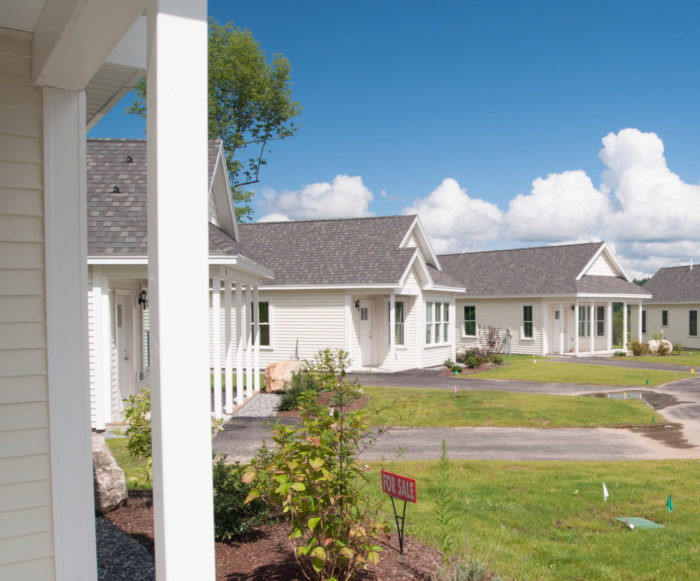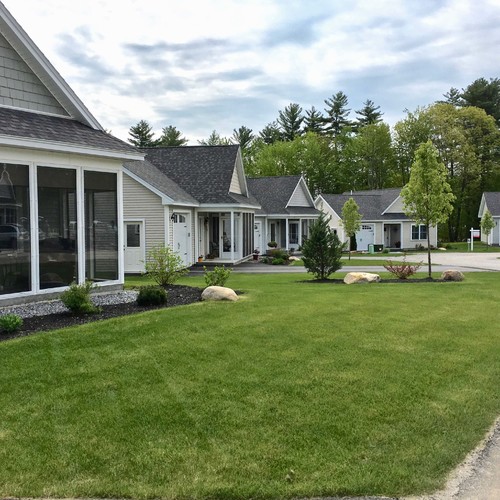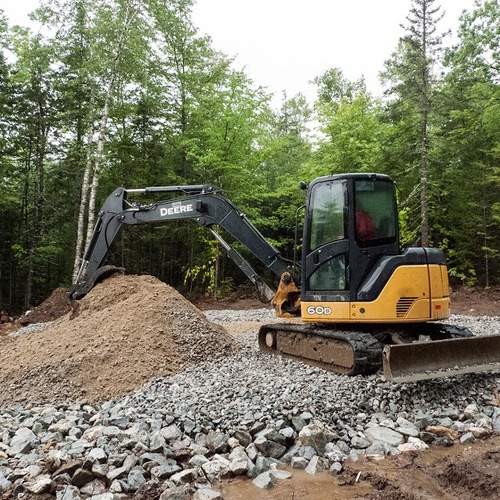
Image Credit: Images #1 through #8: Scott Gibson
Image Credit: Images #1 through #8: Scott Gibson Buyers have the option of a screened porch. The basic 610-square-foot model goes to 640 square feet with a slight change in layout and the addition of a screened porch. Privacy, but not far from neighbors: Developers planned distinct pods of houses to create small neighborhoods that enhance a sense of community. Residents own both their houses and the lots on which they are built. The solar option: For an extra $9,000, residents get a rooftop PV array with a capacity of about 3 kilowatts. It's sized to take care of electric loads for heating and cooling, but not designed to get the house to net-zero. Heating and cooling are managed by a Fujitsu ductless minisplit, capable of providing heat at 15 below zero. Supplemental heat is provided by baseboard electric resistance heaters in each room. The master bedroom is 16 feet by 10 feet. It has one closet and a utility space for a washer/dryer. The kitchen and adjoining living area is the focal point of the house. At the front of the house near the entry, there's a second room that could be used as an office, another living area or a bedroom. The bathroom has a shower but not a tub. The living/dining area is at one end of the kitchen in this 610-square-foot model. (Photo courtesy Cottages at Willett Brook)
Image Credit: Image #9: Cottages at Willett Brook A community clubhouse is a central gathering spot, with kitchen facilities, mail pickup, and a recycling center. Downstairs is a fitness center.
Image Credit: Image #10: Scott Gibson
Judging by the constant stream of visitors to their fledgling housing development in Bridgton, Maine, developers Justin McIver and Mark Lopez think they’ve found just the right mix of energy efficiency, price, and amenities for older buyers.
Yet the first thing prospective buyers are likely to notice about these houses is their size. Unless buyers are just moving out of a New York City studio, these places will probably have a lot less square footage than what they’re used to. Houses in the first “pod” of 10 units come in two sizes, 610 and 640 square feet.
Even so, Lopez would rather you didn’t confuse them with the 250-square-footers of the tiny house movement. They’re not tiny houses, Lopez says, “they’re tiny mansions.”
When fully built out, The Cottages at Willett Brook will consist of 60 units in six pods. Construction on the first group of houses, plus garage/storage units and a central clubhouse, started in April. Work is just starting on a second pod that will include homes of 900 square feet. The development is close to both a hospital and a supermarket and it’s in a popular lakes region about an hour northwest of Portland. It’s prime retirement country.
McIver’s company, Maine Eco Homes, was already building high-end energy-efficient designs. With this project, he’s also offering buyers fewer maintenance headaches, predictable costs, and the chance to unload possessions they no longer want or need — all part and parcel of living in a really small house.
“It came from a combination of things,” the 31-year-old McIver says of the idea behind the development. “People looking to downsize, people tired of heating their homes, maintaining their big homes, their inefficient homes. People came to us and said, ‘We’re spending $700 or $800 a month on heating fuel and we’re still cold.’ Putting together what people want and what they don’t want, we came up with this concept that less is more.”
Energy costs modeled at $1.25 a day
Bridgton, in Climate Zone 6, can see the number of heating degree days top 8,000 a year. And in a state where fuel oil heats 70% or more of all homes, and a lot of the housing stock is old, heating costs can weigh heavily on homeowners with fixed or limited incomes.
That helps explain a marketing plan that emphasizes low energy costs — essentially free heat and air conditioning when buyers spend an extra $9,000 for a 3-kW photovoltaic (PV) array, the developers said. Even prospective homeowners who don’t know a lot about renewables catch on quickly.
“It’s our job to educate them, and the education is as simple as the economics,” says Lopez, a 51-year-old commercial real estate developer who also has a background in residential construction. “When you tell someone that if they opt to put the solar panels on that they’re looking at a calculated energy cost of $1.25 a day — $35 a month — that’s pretty compelling for them to make that investment. It gives them a hedge against increased rates in the future, and the rates aren’t going anywhere but up.
“It’s an easy education,” he continues. “When you tell them it’s the same price as a medium ice coffee at McDonald’s every day for their heating costs, it’s pretty compelling.”
McIver says that the grid-tied PV systems are designed to handle the electrical load of the space heating and cooling equipment, but not lights and other plug loads, and are probably not robust enough for net-zero energy operation for year-rounders. If the house were used as a vacation or seasonal residence, the PV array might be big enough to take care of all energy bills.
Lot sizes in the age-restricted community range from 3,000 to 7,000 square feet. Homeowners will pay $115 a month in association fees that will cover snow removal, yard maintenance, and irrigation. Taxes are estimated at $150 a month.
No aspirations for Passivhaus performance
Lopez and McIver have chosen construction details carefully. They’re looking for reasonable performance without spending so much on insulation, air-sealing, and other details that buyers can’t afford to buy a house.
The slab-on-grade houses are framed with 2x4s (24 inches on center) with raised-heel truss roofs and insulated with a combination of rigid foam, spray foam, and cellulose. Exterior walls are sheathed with Huber’s Zip System R-Sheathing, a panel combining polyiso rigid insulation with a structural layer (total R-value 6.6, according to Huber) plus 2 1/2 inches of closed-cell polyurethane foam for an R-value of about 23 at the center of a stud cavity.
The roof is insulated with 15.5 inches of blown-in cellulose, which according to the developers provides R-53. The foundation is insulated with 2 inches of rigid foam board.
Other details:
- Domestic hot water: Electric tank-style heater.
- Whole house ventilation: Panasonic WhisperGreen fan for continuous ventilation.
- Windows: Double-glazed vinyl units manufactured by Paradigm.
- Roofing: Asphalt shingles.
- Siding: Vinyl.
McIver said that his background in high-performance building includes one of the first net-zero energy houses in Maine, but it sometimes makes more sense to add a couple of extra PV panels to overcome heat losses than it does to spend a lot more for insulation and the careful attention to detail that rigorous air-sealing requires.
Lots of interest in a short amount of time
The first Cottage at Willett Brook is a mile away from the development and more than a year older. Lopez and McIver built a model home first and parked it last year by the side of the road not far from the Hannaford’s supermarket in a spot that plenty of people would pass.
“The first weekend we had that open was Labor Day weekend 2014,” Lopez said, “and in the first six hours we had 150 people come through. It was staggering. There isn’t another development in New England that this many people come through the door.” In the year since, McIver estimates 2,000 or more have stopped in for a look.
They think the small footprints and low heating costs help, and McIver thinks there’s a “conscience factor.” Prospective buyers like the idea that the houses have small environmental footprints.
“Another reason this works in rural Maine is that we have an aging population,” adds Lopez. “What happens when you get well beyond 55, to 70 or 80, is there’s a feeling of loneliness that starts to develop as people become isolated. This gives them privacy, but also a sense of community. They like the fact that their wall isn’t attached to someone else’s wall, but if they sit on their porch they can talk to their neighbor.”
A real life test of their marketing strategy
As the three of us sat in the clubhouse talking about all of this one recent afternoon, a car would occasionally turn in and take a slow lap around the existing housing pod. They’d pull back out on the road and drive away. But one of the cars pulled up and stopped in front of the building after their inspection, and soon thereafter, in walked a couple.
“Well, what do you think?” McIver asked.
“Well,” the man said, “it would be an adjustment.”
The man, a retired teacher, explained they were in the early stages of looking for a new place to live. They’d been to Old Orchard Beach, and were planning a look in the neighboring town of Norway. They’d read about The Cottages project in the paper. The man, 74, said he now owned a modular home and adjacent camp on 1 1/2 acres near a lake in a town not too far away. He had a big garage filled with woodworking equipment and a sizable yard.
And while not in a hurry to make a move, it’s clearly on his radar.
“I’m not sure we want to do that any more,” he said. “The landscaping, the shrubbery. I’m not sure I want to do winter again, either.”
Later, McIver said he understands that moving into a 600-square-foot house can seem like a daunting transition at first. That’s one reason the development is putting up separate buildings that contain garage and storage space, which can be rented separately if people moving into the project find they just have too much stuff.
“You can rent one for a year,” he said. “We know people are going to be downsizing and have a lot of stuff. That gives you a little more time to get rid of things.”
Weekly Newsletter
Get building science and energy efficiency advice, plus special offers, in your inbox.















7 Comments
Center cavity R typo?
"The slab-on-grade houses are framed with 2x4s (24 inches on center) with raised-heel truss roofs and insulated with a combination of rigid foam, spray foam, and cellulose. Exterior walls are sheathed with Huber's Zip System R-Sheathing, a panel combining polyiso rigid insulation with a structural layer (total R-value 6.6, according to Huber) plus 2 1/2 inches of closed-cell polyurethane foam for an R-value of about 23 at the center of a stud cavity."
2x4 cellulose is ~ R13 center-cavity, ZIP-R another R6 (not 6.6- the other 0.6 is the OSB, not insulation), and 2.5" of ccSPF is good for ~R15-R17. That's about R33, not R23. Even the whole-wall R over R23 given that R15 continuous ccSPF and R6 ZIP-R adds up to R21 even berore counting up cellulose filled studs, interior gypsum, siding, etc.
Or, did that mean to imply there was 2.5" of ccSPF wasted in the stud bays (potentially R16-R17), to which they added the R6 ZIP-R added up to R23, no cellulose in the walls? (If that's the case, a full 3.5" cavity fill of ocSPF would be cheaper, greener and higher-R due to the lower thermal bridging, despite a slighly lower center-cavity R.) Did they need the 2.5" ccSPF for structural strength, given teh 24" o.c. 2x4? )
The true performance of ZIP-R in a zone 6 climate is more than a bit suspect as well, due to the polyiso temperature derating issues on the cold side of the assembly.
Response to Dana Dorsett
Dana,
I don't know where you got the impression that there is any cellulose in the walls. Scott never wrote that.
Here is where the mention of cellulose occurs: "The slab-on-grade houses are framed with 2x4s (24 inches on center) with raised-heel truss roofs and insulated with a combination of rigid foam, spray foam, and cellulose." This is a description of all of the different types of insulation used for "the slab-on-grade houses."
He also wrote, "The roof is insulated with 15.5 inches of blown-in cellulose."
When it comes to the walls, there is no mention of cellulose. Instead, Scott wrote, "Exterior walls are sheathed with Huber's Zip System R-Sheathing, a panel combining polyiso rigid insulation with a structural layer (total R-value 6.6, according to Huber) plus 2 1/2 inches of closed-cell polyurethane foam."
You may be correct that there are better ways to insulate walls.
COOL!
I checked out one of these in Bridgton last summer (my old stomping grounds) - It was left open and the sheetrock taping was drying out. Everyone had gone to lunch or something. It was really impressive and really does represent a lovely sweet spot on size/efficiency/budget. I also like that they are pushing the community aspect.
I live in a 700 sq/ft home
I live in a 700 sq/ft home and its small, not enough for more then one person. However layout makes or breaks a small house, my place was designed badly and added onto over time so they had to compromise on layout, but if not done properly 600 sq/ft is very difficult to live in. If thought out extremely well then it can work. However when you get that small you have to think and rethink and think again to make sure the space will work, and storage space is a major problem, even as a minimalist my current place can't easily hold the essentials of living, clothes, sofa, toiletries, food, pots and pans, beds, computer, TV, fridge, stove and no dishwasher possible.
You have to very careful of everything, from door and window placement to mattress size (queen size takes up almost entire rooms) to blenders and slow cookers and tea kettles, i don't have these items because there is nowhere to keep them (and fortunately i am not a tea or coffee drinker). Also kitchen counter space is compromised by small size, so again layout is extremely, extremely important when you get to this small size.
Not Passive House, but can they at least meet code-min?
IRC 2012 code min for zone 6 is R13 +10c.i. or R20+ 5c.i.. Assuming (generously) there is 2.5" of R7/inch ccSPF in the walls that's R18 cavity fill, and the R6 ZIP-R would not make up for that even if if polyiso didn't have performance issues in that stackup.
At a 20% framing fraction (probably about right for 24" o.c. 2x4) an R13 full-fill and R6 ZIP-R would have come in at about R16.15 whole wall, counting the OSB and gypsum (R17 counting interior & exterior air films.)
But with 2.5" of R7/inch foam it's about R15.9 (R16.75 with air films)due to the shorter thermal bridge. With R6/inch spray foam it's R15.33 (R16.18 w/films.)
A code-min R13+ 10 c.i. (center-cavity R23) at a 25% framing fraction (16" o.c. framing, not 24") would be about R19-R20-ish.
A code-min R20+ 5 c.i. (center-cavity R25) at a 25% framing fraction (16" o.c. framing, not 24") would also be about R19-R20-ish.
Seems like even without derating the polyiso, any way you cut it that wall is ~20-25% shy of the prescriptive code-min performance. The designer seems to be assuming the ~R17 cavity fill + R 6 c.i. of the ZIP-R is somehow the thermal equivalent to R13 + 10c.i. , if only because the center-cavity R is also R23, but there's considerably more thermal break over the framing fraction with R10 c.i. than R6 c.i. ZIP (even if it performed at R6.) But if R20 + 5 is the alternative due to the higher-R thermal bridge of 2x6 framing, how was R17+ R6 (at less than half the thermal bridge R) supposed to be somehow equivalent?
In dream-land you might give it another R0.5-R0.8 for the air films inside the 1" deep cavity, but there's no way that wall is even close to code-min performance.
Taxes are $150 a month!
Wow in Illinois mine work out to about $45 a day. No wonder everyone is leaving Illinois.
House size minimums
My community has quite a few new, energy-efficient homes ranges from 800 to 2,000 square feet. (There are larger homes as well.) From what I gather, the 800 to 1,200 sq/ft ones are a bit of a squeeze, especially when the space in split between two floors.
Log in or create an account to post a comment.
Sign up Log in